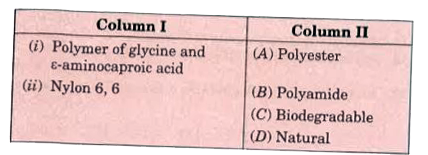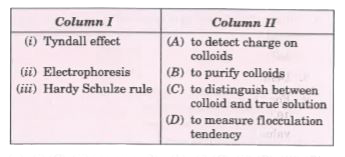Match the food additive (column I) with its class (column II).

A
(i) - (A), (ii) - (B)
B
(i) -(C), (ii) - (D)
C
(i) - (C), (ii) - (B)
D
(i) - (C) , (ii) - (A)
Video Solution
Text Solution
The correct Answer is:B
|
Answer
Step by step video, text & image solution for Match the food additive (column I) with its class (column II). by Chemistry experts to help you in doubts & scoring excellent marks in Class 12 exams.
Updated on:21/07/2023Topper's Solved these Questions
- CHEMISTRY IN EVERYDAY LIFE Book:MODERN PUBLICATIONChapter:CHEMISTRY IN EVERYDAY LIFE Exercise:REVISION EXERCISE (PASSAGE BASED QUESTIONS)
Explore 5 Videos
- CHEMISTRY IN EVERYDAY LIFE Book:MODERN PUBLICATIONChapter:CHEMISTRY IN EVERYDAY LIFE Exercise:REVISION EXERCISE (ASSERTION REASON QUESTIONS)
Explore 10 Videos
- CHEMISTRY IN EVERYDAY LIFE Book:MODERN PUBLICATIONChapter:CHEMISTRY IN EVERYDAY LIFE Exercise:QUICK MEMORY TEST (CHOOSE THE CORRECT ALTERNATIVE )
Explore 10 Videos
- BIOMOLECULESBook:MODERN PUBLICATIONChapter:BIOMOLECULESExercise:UNIT PRACTICE TEST FOR BOARD EXAMINATION
Explore 13 Videos
- D AND F-BLOCK ELEMENTSBook:MODERN PUBLICATIONChapter:D AND F-BLOCK ELEMENTSExercise:UNIT PRACTICE TEST
Explore 12 Videos
Similar Questions
Knowledge Check
Match the polymer (column I) with its important use (column II)
 A(i)−(C),(ii)−(D),(iii)−(B)B(i)−(C),(ii)−(B),(iii)−(D)C(i)−(B),(ii)−(C),(iii)−(D)D(i)−(C),(ii)−(A),(iii)−(D)
A(i)−(C),(ii)−(D),(iii)−(B)B(i)−(C),(ii)−(B),(iii)−(D)C(i)−(B),(ii)−(C),(iii)−(D)D(i)−(C),(ii)−(A),(iii)−(D)Match the class drug (column I) with its example (column II).
 A(i) - (C) , (ii) - (B)B(i) - (C) , (ii) - (A)C(i) - (B) , (ii) - (A)D(i) - (D) , (ii) - (A)
A(i) - (C) , (ii) - (B)B(i) - (C) , (ii) - (A)C(i) - (B) , (ii) - (A)D(i) - (D) , (ii) - (A)Match the polymer (column I) with the class of polymer (column II)
 A(i)−(C),(ii)−(B)B(i)−(A),(ii)−(B)C(i)−(B),(ii)−(D)D(i)−(C),(ii)−(A)
A(i)−(C),(ii)−(B)B(i)−(A),(ii)−(B)C(i)−(B),(ii)−(D)D(i)−(C),(ii)−(A)
Match the type of colloid (column I) with its property (column II)

View SolutionMatch the column I with the column II.

View SolutionMatch the detergent (column I) with its type (column II) .

View SolutionMatch the oxide of manganese (column I) with its nature (column II)

View SolutionMatch the method (column I) with its example (column II)

View Solution

